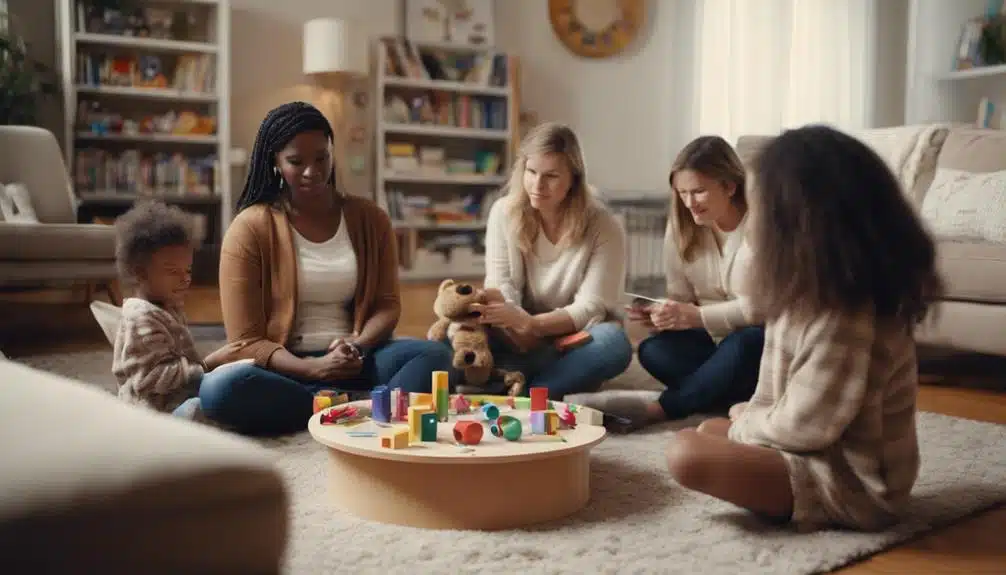Discover the transformative power of Family-Focused Autism Therapy, a collaborative approach that empowers individuals with autism spectrum disorder while strengthening family bonds. This method addresses developmental needs through seven key strategies and cultivates an environment conducive to growth and understanding. Each plan offers a unique perspective on autism challenges, with their combined synergy potentially redefining therapy outcomes.
By exploring how these strategies interlink and amplify each other, families can embark on a journey toward improved lives and enhanced support for children with autism. Autism spectrum disorder affects not only the lives of children with autism but also their families, impacting daily life and social situations. Children with autism spectrum conditions often struggle with communication skills, social behavior, and challenging behaviors, which can create stressful situations for both the child and their family.
However, with Family-Focused Autism Therapy, parents and extended family members are equipped with evidence-based practices and family therapy techniques to support the child’s development and improve their quality of life. Through cooperative family approaches and therapeutic interventions, families create supportive environments where the child with autism can thrive, fostering a sense of calm and control within the family unit.
Key Takeaways
- Collaborative therapy enhances outcomes by integrating professional guidance with family involvement.
- Setting clear, measurable goals is crucial for tracking progress in autism therapy.
- Play-based learning strategies significantly improve developmental skills and social interactions.
- Support for family well-being is essential in creating a nurturing environment for children with autism.
Understanding Autism Together
Understanding autism together requires a harmonious blend of professional guidance, familial empathy, and a deep dive into evidence-based strategies. This ensures that every family member’s perspective is acknowledged and valued in the journey towards comprehensive support. Autism, a neurodevelopmental disorder, presents unique challenges in communication, social interaction, and behavior that necessitate a multifaceted approach to intervention. Families, pivotal in the support network, must embrace a collaborative stance with professionals to unlock therapy’s full potential.
Educating family members about autism fosters empathy and equips them with the necessary skills to improve communication and understanding within the household. This educational foundation is critical for implementing effective strategies that cater to the individual’s strengths and differences in processing information and interacting with the world. The collaboration between families and professionals enhances the intervention process, making it more tailored and responsive to the individual’s needs.
In essence, the collective effort to understand autism lays the groundwork for a supportive environment where individuals with autism can thrive. Through this collaborative approach, families can play an active role in therapy, contributing to developing interventions that promote meaningful improvements in communication and social skills.
Establishing Communication Goals
Establishing clear communication goals is a critical next step in therapy for individuals with autism. Building on the foundation of mutual understanding between families and professionals, setting these goals structures therapy sessions more effectively and ensures that each session is purposefully directed toward meaningful outcomes. Whether they aim to enhance verbal or nonverbal skills, communication goals must be meticulously tailored to meet the individual needs of each family member. This personalized approach acknowledges the unique challenges and strengths of the family unit, making therapy more impactful.
Moreover, the importance of making communication goals measurable cannot be overstated. Objective measures and observations enable tracking progress, providing tangible evidence of improvements, or highlighting areas needing further attention. This evidence-based approach facilitates a cycle of regular reassessment and adjustment of goals, ensuring that therapy remains dynamic and responsive to the family’s evolving needs.
By engaging in this continuous process of setting, tracking, reassessing, and adjusting communication goals, family members are empowered to actively participate in therapy, fostering collaboration and shared responsibility in the journey toward effective communication.
Integrating Play-Based Learning

Integrating play-based learning into family-involved autism therapy offers a multifaceted approach to enhancing vital developmental skills in autistic children. Pediatric occupational therapists can effectively foster improvements in social interaction, communication abilities, and cognitive growth through carefully selected games and activities. This method supports the child’s developmental needs and strengthens the therapeutic relationship, providing a foundation for successful intervention.
Benefits of Play Techniques
Play techniques, when incorporated into autism therapy, have been demonstrated to significantly enhance social, communicative, and emotional skills in children with Autism Spectrum Disorder (ASD). By embracing a methodology centered around play, children benefit in ways that are both profound and multifaceted:
- Social Skills Enhancement: Play techniques facilitate improved interactions with peers and adults, fostering a sense of belonging and acceptance.
- Communication Growth: Through role-play and storytelling, children with ASD enhance their verbal and non-verbal communication abilities.
- Emotional Regulation: Playing helps children express and manage their emotions more effectively, reducing anxiety and stress.
- Cognitive and Problem-Solving Development: Play-based learning encourages imaginative thinking, boosts mental abilities and problem-solving skills, and promotes greater independence and confidence in children with ASD.
Implementing Games Effectively
To effectively harness the benefits of play-based learning in autism therapy, it is crucial to design and implement games tailored to the unique developmental needs and goals of children with Autism Spectrum Disorder (ASD). Integrating games into therapy sessions provides a natural and enjoyable learning environment and significantly enhances social skills, communication, and cognitive development. By focusing on activities that promote turn-taking, sharing, and rule-following, children with autism can practice essential life skills in a supportive setting.
Tailoring these games to target specific therapeutic goals, such as emotional regulation or language development, maximizes their effectiveness. The research underscores the positive impact of play-based interventions on social interactions, problem-solving abilities, and overall well-being, highlighting the importance of games in fostering engagement, motivation, and active participation in therapy.
Creating Consistent Routines
Creating consistent routines within family-involved autism therapy begins with identifying daily activities essential for the individual’s development and well-being. Effectively structuring time, including predictable sequences of these activities, can significantly reduce stress and enhance the ability to navigate transitions more smoothly. Reinforcing the success of these routines through visual aids and positive feedback is pivotal in promoting independence and fostering a sense of accomplishment in individuals with autism.
Identifying Daily Activities
In the realm of autism therapy, identifying and structuring daily activities is pivotal, as it lays the foundation for creating consistent routines that significantly ease the challenges faced by individuals with autism, such as anxiety and difficulty with transitions.
- Structure and Predictability: Implementing daily routines enhances predictability, reducing anxiety and improving communication.
- Skill Development: Scheduling activities tailored to individual strengths fosters skill improvement, independence, and effective transition management.
- Behavior and Attention: Routine-based interventions enhance behavior, focus, and task completion.
- Visual Schedules and Prompts: Utilizing visual schedules and prompts supports understanding expectations, aiding individuals in following daily routines and promoting engagement and motivation in therapy sessions.
Structuring Time Effectively
Effective structuring of time is essential for individuals with autism, as it fosters a stable environment that mitigates anxiety and enhances overall well-being. Consistent routines offer predictability, significantly reducing stress and instilling a sense of security. Structured time management, using visual schedules and timers, simplifies understanding expectations and navigating transitions, improving behavior and emotional regulation. Moreover, the establishment of clear and consistent routines, both at home and school, enables effective daily activity navigation.
Applying structured time management within therapy sessions significantly boosts engagement, participation, and learning outcomes. This holistic approach to time organization underscores the critical role of structured environments in supporting individuals with autism to thrive.
Reinforcing Routine Success
To ensure individuals with autism thrive, reinforcing routine success through the establishment of consistent schedules is paramount, as it provides a structured framework that reduces anxiety, enhances behavior regulation, and promotes independence.
- Predictability and Structure: Establishing consistent routines offers a sense of security, significantly reducing stress and anxiety levels, thereby creating an environment conducive to learning and growth.
- Behavior Regulation: A well-structured day can improve behavior, as individuals understand what is expected of them and when.
- Independence and Confidence: Successfully navigating a routine fosters self-reliance and boosts self-esteem, encouraging more autonomous task completion.
- Enhanced Communication and Social Skills: Regular interactions within predictable frameworks improve verbal and non-verbal communication, aiding in better social integration and interaction.
Managing Behavioral Challenges
Addressing behavioral challenges in individuals with autism requires a multifaceted approach that integrates positive reinforcement, structured routines, and consistent collaboration among caregivers, therapists, and educators. Behavioral challenges such as aggression, self-injury, noncompliance, and tantrums can significantly impact daily functioning and the overall quality of life for individuals with autism and their families. Caregivers can create a supportive and predictable environment that encourages positive behaviors by combining evidence-based strategies, including DIRFloortime and Applied Behavior Analysis (ABA) techniques, visual schedules, and environmental modifications.
| Strategy | Description | Example |
|---|---|---|
| Positive Reinforcement | Encouraging desired behaviors by rewarding them. | I am giving praise or a token for completing tasks. |
| Structured Routines | It is establishing a consistent daily schedule to reduce anxiety and uncertainty. | I am using visual schedules to outline daily activities. |
| Collaboration | We are working together with professionals and family members to implement behavior plans. | Regular meetings to discuss progress and adjust strategies. |
Implementing these strategies requires patience, consistency, and a deep understanding of each individual’s unique needs and triggers. With a compassionate and collaborative approach, managing behavioral challenges in autism therapy becomes an achievable goal, fostering an environment where individuals with autism can thrive.
Encouraging Sibling Participation

Building on the foundation of managing behavioral challenges, encouraging sibling participation in autism therapy emerges as a crucial element in strengthening family dynamics and support systems. This approach fosters understanding and empathy among s. It significantly enhances the therapeutic journey for the family, creating a nurturing environment where everyone’s needs are acknowledged and addressed.
Here are four pivotal reasons why sibling participation is invaluable:
- Fosters Understanding and Empathy: Siblings gain an intimate understanding of the autism spectrum, which fosters empathy towards their sibling’s unique perspective.
- Enhances Communication: Involving siblings in therapy introduces them to tailored communication strategies, aiding smoother interactions and reducing misunderstandings within the family dynamic.
- Improves Family Cohesion: Active participation helps siblings recognize challenges and strengths, promote unity and shared responsibility, and strengthen family bonds.
- Reduces Isolation: Engaging siblings in therapy sessions helps mitigate feelings of isolation, bolstering bonding and fostering a supportive family environment where everyone feels valued and involved.
Nurturing Family Well-Being
Nurturing the well-being of the entire family, particularly in the context of autism therapy, is a cornerstone for enhancing the overall outcomes and quality of life for individuals with ASD and their loved ones. Family-involved autism therapy not only supports the individual with ASD but also strengthens family cohesion, which research suggests is crucial for positive therapy outcomes.
| Focus Area | Benefits | Strategies |
|---|---|---|
| Communication | Enhances understanding | Active listening, open dialogues |
| Coping Skills | Improves resilience & stress reduction | Problem-solving, mindfulness |
| Support | Fosters a nurturing environment | Community resources, peer groups |
| Resilience | Builds capacity to adapt | Positive reinforcement, flexibility in routines |
| Quality of Life | This leads to improved relationships | Shared activities, celebrating achievements |
Family therapy sessions that build resilience, improve communication, and foster a supportive atmosphere can significantly reduce stress, increase understanding among family members, and enhance coping skills. Prioritizing family well-being in autism therapy not only benefits the individual with ASD but also leads to better outcomes and improved quality of life for all family members involved.
Frequently Asked Questions
What Are the Techniques of Strategic Family Therapy?
Strategic family therapy employs techniques such as reframing problems, creating targeted interventions, and establishing clear goals. It utilizes paradoxical interventions to challenge dynamics and promotes brief, solution-focused strategies to address issues within the family system efficiently.
What Are the Goals of Family Therapy for Autism?
The primary objectives of family therapy for autism are to enhance communication skills, foster understanding and empathy, develop stress management strategies, and strengthen familial relationships, thereby creating a supportive environment for all members to flourish.
What Is Family-Focused Autism Therapy?
Family-based treatment for autism is an integrative approach that incorporates the entire family in therapy to support the individual with autism. It emphasizes enhancing communication, relationships, and coping mechanisms within the family dynamic.
How Can I Help My Family With Autistic Children?
To assist families with children with autism, it’s crucial to provide emotional support, educate on autism spectrum disorders, promote open communication, utilize community resources, and practice patience and empathy to create a nourishing and understanding environment.
Conclusion
Families with children on the autism spectrum can face unique challenges in their daily lives. Navigating autism therapy can be a difficult task and often requires a cooperative family approach. Using evidence-based practices, family support interventions, and family systems approaches can be a powerful tool for families to enhance the lives of children with autism.
DIRFloortime therapy is a therapeutic intervention used to help children with autism spectrum disorder. This approach is specifically designed to improve communication, social, and daily living skills in children with autism. Positive reinforcement, visual aids, and alternative therapies can also be incorporated into DIRFloortime therapy to enhance its effectiveness in treating autism spectrum conditions.
Family therapy techniques can be an effective way to address challenging, disruptive, and aggressive behaviors in children with autism. Therapists use narratives, sign language, and body language to help children with autism communicate. Additionally, breathing techniques like square breathing can help children with autism manage anxiety in stressful situations.
It is also important to create supportive environments where children with autism can feel safe and have a sense of control. Family therapy can help parents of children with autism develop skills to manage their child’s behavior better. The American Psychiatric Association recommends family therapy as an effective intervention for children with developmental delays or mental disorders. Families of children with autism can benefit from family support interventions, which create a sense of calm in the home and promote a sense of unity in the family.
In conclusion, families of children with autism spectrum disorder can enhance the quality of life for their loved ones by using family systems approaches and therapeutic interventions. The effectiveness of family therapy has been well-documented in the Journal of Family Therapy. Working with trial authors and experts in the field is essential to ensure the best possible treatment for children with autism.


Recent Comments